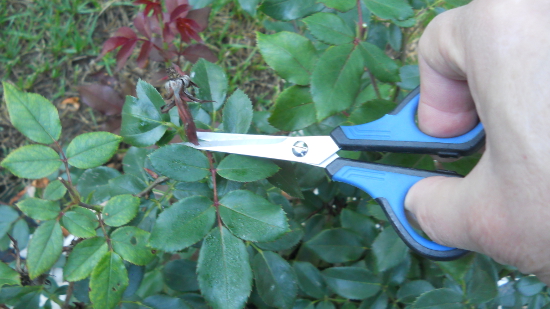Rose Deadhead is about how to trim roses properly. This architectural firm has had roses for the last decade and discovered the following:
You should deadhead your roses. That means: after each beautiful bloom is done looking fresh and starts to wilt, you should cut it off with scissors or garden shears. But you don’t cut just anywhere. You cut the stem down 1/4″ above the first 5 leaf cluster and you cut at an angle.
Continued below:
Don’t cut at the 3 leaf clusters or any other number of leaf clusters, just above the 5 leaf cluster. Why: because that cut point is where a new rose flower will bloom. Cuts in other location may result in barren stem growth. And that’s not the purpose of roses, usually. If what you’re after is flowers, cut as indicated.
Here’s another photo of another cut in progress:
Just above the 5 leaf cluster.
Now then, here’s some more information. After a flower wilts, you will probably notice necrotic tissue (dead) on the stem, leading back down. You should make sure you remove the necrotic tissue, because that is dead. And dead tissue doesn’t help grow anything on a plant. Even it means going further down the stem to another lower 5 leaf cluster.
Continued below:
FERTILIZER/DISEASE CONTROL/INSECTICIDE
The experience of this firm has been that Bayer All-in-One Rose & Flower Care does a great job. It has Fertilizer to help the rose plant grow, Insecticide to help combat beetles, aphids, caterpillars and other pests, and Disease Control to help reduce black spot, powdery mildew, rust and southern blight. The container indicates it works for up to 6 weeks.
Our firm also puts a little into the ground, when we excavate a hole for the root ball. Don’t overdo; you don’t want to burn them.
And when we plant, we make a larger hole and pour in some Black Kow composted manure. And we water about every 5 days or so, if your environment doesn’t rain. But overdo that; as you could nurture disease.
Following the above methods has routinely worked in western North Carolina, in the USA. Other locations may require variations. All the best with your garden.


